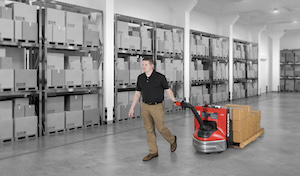Binghamton University, Raymond Corp. and NYSEG partner to create more sustainable warehouses
The project is designed to demonstrate why a behind-the-meter storage system and controllable forklift charging can be beneficial for warehouse owners and the utility grid.

Faculty at Binghamton University, State University of New York will develop and demonstrate a new energy storage process and solution for warehouse energy management. The solution will use solar panels, a stationary energy storage system and lithium-ion batteries on forklifts that will reduce energy costs for warehouse owners.
Funded by the New York State Energy Research and Development Authority (NYSERDA), the project will allow researchers to work with The Raymond Corporation, a leading manufacturer of electric forklift trucks and intralogistics solutions, to develop an economically viable storage demonstration project. The project is designed to demonstrate why a behind-the-meter storage system and controllable forklift charging can be beneficial for warehouse owners and the utility grid. Ziang (John) Zhang, principal investigator, and Pritam Das, co-principal investigator, both assistant professors of electrical and computer engineering at Binghamton University’s Watson
School of Engineering and Applied Science, will work closely with Raymond engineers to manage the energy generation, storage and consumption of lithium-ion batteries in their forklift trucks.
“We are honored to be selected by NYSERDA to support its clean energy initiative with research that includes a solar power system (photovoltaic), a stationary energy storage system, and several forklift battery chargers,” said Zhang. “We believe this partnership with Raymond can give the industry an example of what future warehouse energy systems look like and how it can benefit all parties involved.”
Electric forklift trucks are traditionally powered by lead-acid batteries, which can have an extended recharge time of up to eight hours. In many high-use warehouses, several of these shifts may overlap where each forklift truck may have two or three batteries utilized per truck – one in use, one on recharge, and one cooling down in storage. Lithium-ion batteries provide great benefits to Raymond’s customers, but the fast-charging feature may cause significant energy demands to warehouse owners during peak times, which is why this project was developed.
“Our partnership stemmed from the manufacturing industry’s growing need for more sustainable, more controllable resources,” said Michael Field, chief executive officer of The Raymond Corporation. “By implementing lithium-ion batteries into more forklifts, our customers will see the same high-quality products but with overall energy consumption reduction due to the ability to charge at nearly 100 percent efficiency and reduced costs, on account of the batteries having a longer lifespan.”
The proposed solution can turn warehouses into a controllable energy hub which can be optimized to support the power grid during normal and peak grid conditions. Binghamton University will work with New York State Electric & Gas (NYSEG) to estimate the grid benefit/impact of the proposed system. Preliminary analysis includes an estimation of how the system impacts the efficiency of the local circuit. “Controllable distributed energy resources,
such as battery storage, will pay a significant role in managing the electricity grid in the future.
We are excited to be working with Binghamton University and The Raymond Corporation on this exciting project,” said Carl Taylor, President and CEO of NYSEG and RG&E.
NYSERDA’s project was founded to assist the state in combatting climate change and put it on the path to carbon neutrality. By partnering with Raymond, a New York-based company, this initiative is focused on driving down costs and creating a self-sustaining energy market for both wholesale and commercial businesses in the state. Ultimately, Binghamton University and Raymond will work together to implement changes in warehouses to encourage sustainability, while engaging and educating the local community on their efforts.
“This is an excellent example of how companies are pushing beyond the status quo to bring clean energy technologies into their workplace while supporting Governor Cuomo’s nation-leading clean energy goals,” said Alicia Barton, president and CEO of NYSERDA.
“Incorporating multiple clean energy technologies into one system, such as this project, will enable warehouses to become more energy efficient, save money and increase productivity, while making their buildings healthier for workers.”
This project builds on a previously NYSERDA-funded project completed by Raymond in 2017 which showed the advantages to using lithium-ion batteries for energy storage on forklifts. The earlier project developed methods for the battery, truck and charger to communicate temperatures, state of charge and other status information, as well as demonstrate improved performance while the forklifts were in use.
Contributing to this project from The Raymond Corporation are Steven Medwin, director of energy solutions; Stephen Bentley, operations project manager; and John Kirk, research engineer. Scott Bochenek, manager of AVANGRID’s Smart Grid Programs, is also involved in this project.

Article Topics
Energy News & Resources
EnerSys showcases IP54-rated charger Stoecklin Logistics introduces new company CEO Delta showcases wireless charging solutions and machine vision solutions for smart logistics CaPow’s power-in-motion solution eliminates charging downtime Plug Power completes first Installation of electrolyzer at Amazon fulfillment center Concentric acquires Jantech, provider of uninterruptable power solutions Wiferion’s wireless charging business acquired by industrial power supply provider PULS More EnergyLatest in Materials Handling
Registration open for Pack Expo International 2024 Walmart chooses Swisslog AS/RS and software for third milk processing facility NetLogistik partners with Vuzix subsidiary Moviynt to offer mobility solutions for warehouses Materials Handling Robotics: The new world of heterogeneous robotic integration BSLBATT is looking for new distributors and resellers worldwide Lucas Watson appointed CSO for Körber’s Parcel Logistics business in North America Hyster recognizes Dealers of Distinction for 2023 More Materials HandlingSubscribe to Materials Handling Magazine

Find out what the world's most innovative companies are doing to improve productivity in their plants and distribution centers.
Start your FREE subscription today.
April 2024 Modern Materials Handling

Latest Resources










